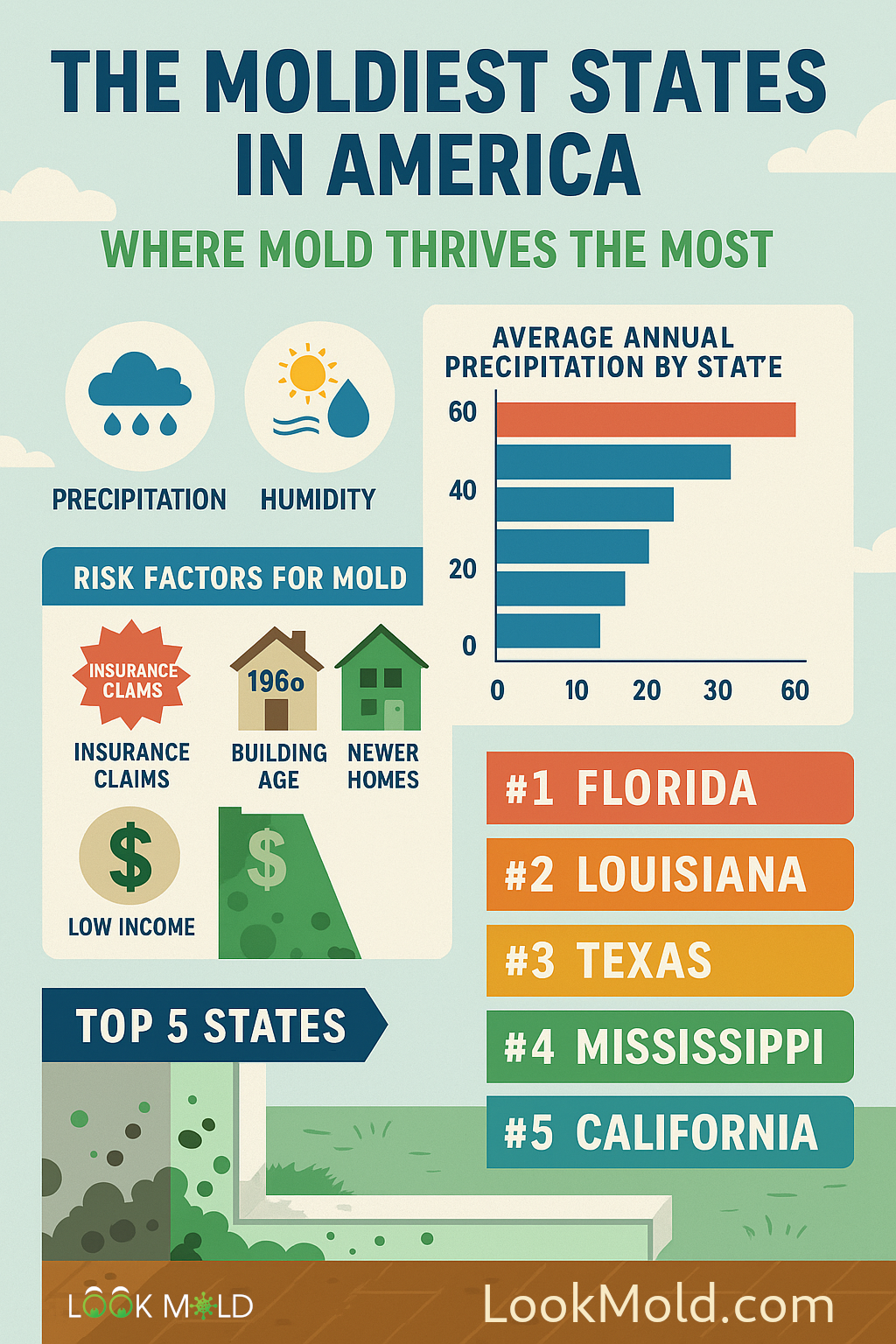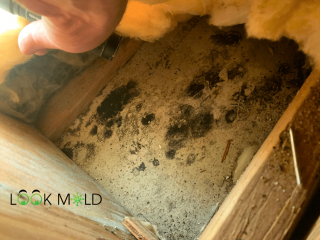The Top 5 Moldiest States To Live In
Expert insight by: Brad Fishbein, Licensed Mold Assessor
Updated April 7, 2025
🌎 No matter where you live in the U.S., mold is a natural part of the environment—and some of it will inevitably end up in your home.
But in some states, mold is more than a nuisance. It’s a persistent, costly, and even dangerous part of life.
This article breaks down the Top 5 Moldiest States in the U.S., based on:
- 📈 Precipitation & Humidity
- 💧 Water Damage Insurance Claims
- 🏠 Building Design & Age
- 👥 Lifestyle & Socioeconomic Factors

🌧️ Climate: The Foundation for Mold Growth
Mold thrives in moist, humid environments. That’s why two key climate indicators—precipitation and relative humidity—are crucial when identifying high-risk areas.
🌀 Precipitation
You might think the Pacific Northwest (like Washington) leads the nation in rainfall, but the data might surprise you.
According to 2019 data, Mississippi topped the list for annual precipitation, not Washington or Oregon.
💧 Humidity
Without elevated humidity, mold struggles to grow—even if there's a leak.
That’s why any qualified mold inspector will first measure relative humidity. Mold spores attach to porous building materials like fabric, drywall, and wood—especially when air is moist.
Fun Fact: You don't need high temps for high humidity.
In fact, Alaska ranks as the most humid state in average relative humidity.
— Aprilaire
📉 Insurance Claims: Where Water Damage Hits Hard
Insurance data reveals another major mold risk factor—water damage claims.
States with high mold activity tend to have:
- More frequent plumbing failures
- More AC and HVAC leaks
- More storm-related water intrusion
Additionally, the rise of older homes, fraud, and public adjusters has driven a spike in water damage claims in recent years.
“Mold thrives in damp conditions, often resulting from leaks, humidity, or flood damage. Insurance claims related to mold are on the rise.”
— FEMA
For homeowners navigating this, understanding your water damage insurance options can make a big difference in protecting your property.
🏠 Building Design & Lifestyle Habits
Where and how homes are built matters:
- Older homes = aging pipes, less ventilation
- Warm climates = ACs run constantly = condensate leaks
- Some states prefer natural ventilation, leaving windows open more often than running ACs
And then there’s plumbing material:
Homes built with polybutylene pipes (common in the 1980s-90s) are ticking time bombs for mold risk due to pipe failure.
🏆 The 5 Moldiest States in the U.S.
1. Florida 🌴
Humidity. Hurricanes. HVAC leaks. Florida has it all.
- Water damage claims jumped 46% between 2010–2015
- Constant AC usage creates more opportunities for leaks
- Short, powerful rainstorms lead to wind-driven rain intrusion
- Mold in HVAC ductwork is common in Florida homes
Florida even changed its insurance laws in 2019 due to excessive claims and fraud—a sign of just how widespread mold issues have become.
“In Florida, if your AC doesn’t dehumidify properly, mold growth is almost inevitable.” — Brad Fishbein, Licensed Mold Assessor
2. Louisiana 🎭
Yes, Hurricane Katrina left its mark—but Louisiana’s mold risk goes far beyond that.
- One of the most humid states in the U.S.
- Swamplands + high dew points = perfect for mold
- Homes built post-1950 = cellulose-rich materials = mold food
- 2017: Highest average home insurance premiums in the country

Mardi Gras may be festive—but mold spores are partying year-round in the Bayou State.
3. Texas 🤠
Texas doesn’t always scream "humid"—but it should.
- Among the first states to require mold licensing (2004)
- Frequent coastal storms and humidity spikes
- Massive population growth = newer, more porous construction
- High water damage claim rates

In spring, especially in cities like Houston or Dallas, mold spores thrive in attics, walls, and air ducts if HVAC isn’t properly maintained.
4. Mississippi 🌧️
A triple threat of mold risk:
-
1 in precipitation
-
1 in average humidity
- One of the poorest states, meaning less access to mold testing
“Lower-income families are 18% less likely to get allergy or mold testing.”
— Quest Diagnostics Allergy Report
This lack of testing increases risk for conditions like black mold exposure, especially among children.
5. California 🌄
You wouldn’t expect it—but mold in California is on the rise.
- More humid summer days than you'd think
(e.g., LA can be more humid than Miami on some days!) - Many older homes lack central AC
→ no dehumidification = moisture buildup during rainy periods - People often overlook mold in favor of other air quality issues like PM 2.5 or wildfire smoke
Mold doesn’t care how trendy or dry your zip code is. If it’s humid and you’ve got a leak, you’ve got a problem.
💬 Final Thoughts: Mold Can Happen Anywhere
While these five states top the list, mold can affect any home in America. The real key is moisture control.
How to Prevent Mold in Any State:
- 🕵️ Regularly inspect for leaks and condensation
- 🌬️ Use dehumidifiers in humid seasons
- 🧼 Clean visible mold with the right products (not bleach!)
- 🧰 Maintain HVAC systems and repair AC leaks promptly
- Learn what mold grows on to spot issues early
- Know when to call in the pros for mold remediation
Explore Related Topics:

Meet the author: Brad Fishbein is an ACAC council-certified Microbial Investigator. In the fall of 2012, he became a Licensed Mold Assessor in the State of Florida through the Department of Business & Professional Regulation. Brad has helped homeowners with over 5,000 successfully completed Mold Inspections since 2009.

